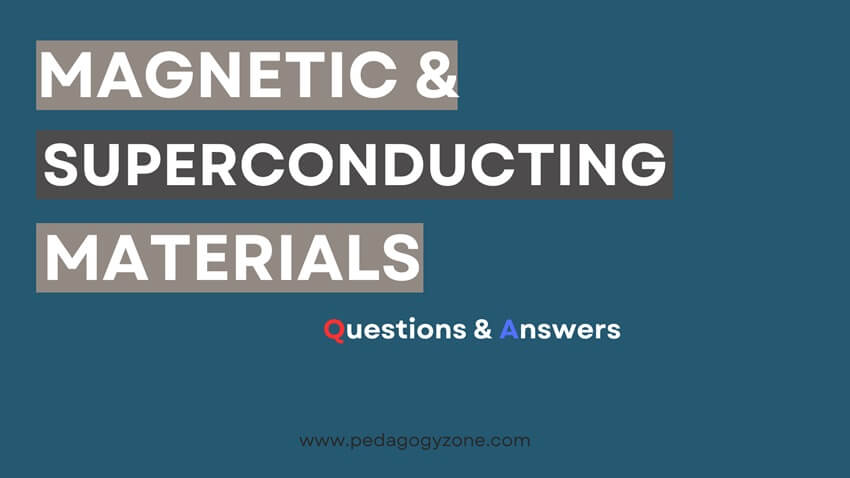
1. What is meant by magnetic materials? Give examples?
Magnetic materials are the materials which can be easily magnetized by keeping it in an external magnetic field.
Examples : Iron, Ferrites, Carbon steel etc.
2. Define Magnetic Flux [φ]
The total number of magnetic lines of force passing through a surface is known as magnetic flux. Unit: Weber.
3. Define magnetic induction (B) or magnetic flux density
It is the number of magnetic lines of force passing perpendicular through unit area of cross section. Unit: Weber /m² or Tesla
4. Define Intensity of magnetic field or Magnetic field strength or Magnetising field intensity (H).
It is the force experienced by an unit north pole placed at the given point in a magnetic field. H=A/m, Unit: Ampere/ metre or N/Wb
5. Define intensity of magnetization (I)
Magnetisation is the process of converting a non-magnetic material into a magnetic material. It is defined as the magnetic moment per unit volume. I = m/V Unit: Weber /m².
6. Define magnetic susceptibility (χ)
It is defined as the ratio of intensity of magnetization produced to apply magnetic field intensity. χ=I/H. The sign and magnitude of χ are used to determine the nature of the magnetic materials.
7. Define magnetic permeability (μ)
It is the ratio of the magnetic flux density (B) to the applied magnetic field intensity (H), μ=B/H Unit: Henry/m.
8. Define relative permeability (μr)
It is defined as the ratio of permeability of the medium (μ) to the permeability of the free space. μr = μ/μ0
9. Define Bohr magneton (μB)
The orbital magnetic moment and the spin magnetic moment of an electron in an atom can be expressed in terms of atomic unit of magnetic moment called Bohr magneton. One Bohr magneton, μB =9.27×10−24Am².
10. Define Diamagnetic materials.
In a diamagnetic material the electron orbits are randomly oriented and the orbital magnetic moments get cancelled. Similarly, all the spin moments are paired (having even no. of electrons). Therefore, the electrons spins in two opposite directions and hence the net magnetic moment is zero.
These materials are called as diamagnetic materials.
Ex: Gold, Ge, Si, Antimony, Bismuth, Silver, Lead, Copper, Hydrogen, Water and Alcohol.
11. Define Paramagnetic Materials.
Paramagnetism is due to the presence of a few unpaired electrons. In the absence of external magnetic field, the magnetic moment (dipoles) are randomly oriented and posses very less magnetization in it.
Ex: Platinum, CuSo4, MnSO4, Palladium, Chromium, Aluminium, etc.
12. Define Ferromagnetic materials.
Ferromagnetism is due to the presence of more unpaired electrons. Even in the absence of external field, the magnetic moments align parallel to each other, so that it has large magnetism. This is called spontaneous magnetization.
Ex: Iron, Cobalt, Ni.
13. What are the properties of Ferromagnetic materials?
- All the magnetic lines of force pass through the material.
- Its susceptibility is high positive and it is given by χ = [C/ (T−θ)]
- The permeability is very much greater than one.
- They have enormous permanent dipole moment.
- When the temperature is greater than the Curie temperature, then the Ferromagnetic becomes paramagnetic.
- The ferromagnetic material has equal magnitude dipoles aligned parallel to each other.
14. What are magnetic domains?
A ferromagnetic material is divided into a large number of small regions called domains. Each direction is spontaneously magnetized. The direction of magnetization varies from domain to domain and the net magnetization is zero in the absence of external magnetic field. The boundary line which separates two domains is called domain wall or Bloch wall.
15. How the external magnetic field helps the magnetization in ferromagnetic material?
When the magnetic field is applied to the Ferromagnetic material, the magnetization is produces in two ways.
- By the motion of domain walls.
- By the rotation of domains.
16. Define Exchange Energy.
The energy which makes the adjacent dipoles to align themselves is know as exchange energy. It is also called as magnetic field energy or magnetostatic energy. It arises from interaction of electron spins and it depends upon the interatomic distance.
17. What is Anisotropy energy?
Crystals are anisotropic. The excess energy required to magnetize a material in particular direction over that required to magnetize it along the easy direction is called Anisotropy energy.
18. What is Domain wall energy (or) Bloch wall energy?
It is transition layer which separates the adjacent domains, magnetized in different directions.
19. What is Magnetostriction energy?
When the domains are magnetized in different directions, they will either expand or shrink i.e., Change in dimension when it is magnetized. The energy produced in this effect is called magnetostriction energy. It is the energy due to the mechanical stresses generated by domain rotations.
20. Define Hysteresis.
Hysteresis means “Lagging behind”. i.e., The Lagging of magnetic induction behind the intensity of magnetic field (H) which is applied is called Hysteresis.
21. What is mean by Hysteresis Loss?
When the specimen is taken through a cycle of magnetization, there is loss of energy in the form of heat. This is known as Hysteresis Loss.
22. Define retentivity and Coercivity.
During process of demagnetization, the material retains some amount of magnetism, even though when intensity of magnetic field is zero. It is known as Retentivity or residual magnetism.
The amount of intensity of magnetic field applied in the reverse direction to remove the retentivity is known as coercivity or coercive force.
| Read More Topics |
| What scale do quantum effects occur? |
| Is Schrödinger father of quantum physics? |
| The underlying concepts of NMR |





